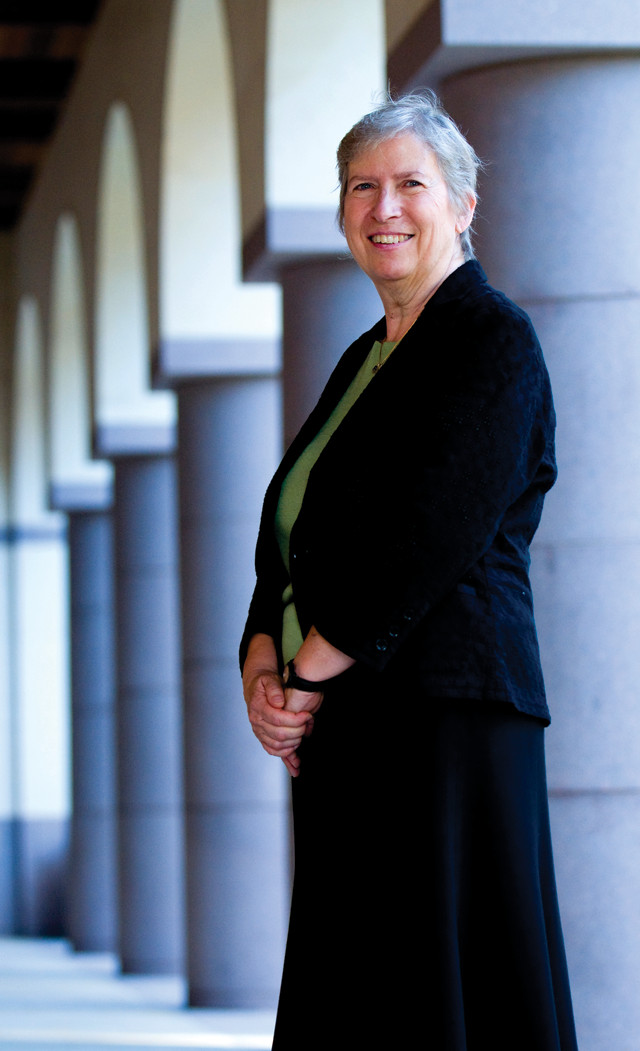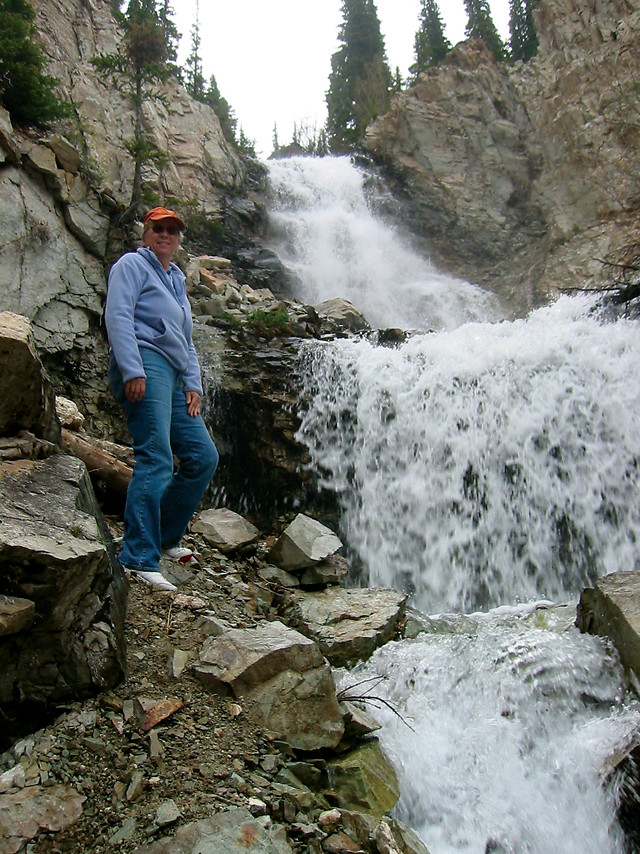
by Erin Wayman Wednesday, May 23, 2018

Sharon Mosher. Credit: Jackson School of Geosciences, University of Texas at Austin
Sharon Mosher was born with a rock in her hand, as her mom used to say. As a child in Illinois, she was fascinated by geology, conducting mineral tests on rocks in the chemistry lab her dad set up for her in their basement. She decided she wanted to be a geologist the moment she learned that’s what you call a person who studies rocks.
Mosher never strayed from that plan. Now a structural geologist at the Jackson School of Geosciences at the University of Texas at Austin, Mosher has spent more than 30 years researching deformation mechanisms at plate boundaries. Her work has taken her from New England to Texas to the Australia-Pacific Plate boundary south of New Zealand.
But Mosher has also worked to further the geosciences in another way. She has devoted much of her time to participating in and leading several scientific organizations. From 2000 to 2001, she was president of the Geological Society of America (GSA), and in 2004, she was chair of the Council of Scientific Society Presidents. Last year, she took over as dean of the Jackson School of Geosciences.
Mosher recently spoke with EARTH’s associate editor Erin Wayman about her goals as dean, the pros and cons of electronic publishing, and the importance of collaboration within the geosciences.
EW: You’ve been the head of many different geoscience organizations. How did you get involved in these sorts of professional activities?
SM: It probably started with the Structural Geology and Tectonics Division [of GSA]. I was one of the founding members and the first elected chair. I was only a couple years out of my degree, but it was something I felt passionate about. At the time, in general, structural geologists didn’t have much to do with people who were doing tectonics. I felt it was important for the two groups to interact with each other. For example, structural geology could constrain tectonic problems and processes. So I thought it was really important to get the two groups together, getting them to interact and go to the same meetings and talks.
I guess all along that’s been the driver: If you can get scientists to work together to address various problems, they can do so much more than they can individually and can find more interesting answers.
EW: Is that what interested you in becoming dean of the Jackson School of Geosciences?
SM: It was just a great opportunity. Because we were given such an incredible [$241 million] gift and have the ability to grow a tremendous program, being able to do something that would benefit the geosciences attracted me. It seemed we had such an unusual opportunity that it was really critical to have somebody in a leadership role that could see the school become a premier institution that was advancing the geosciences, impacting society and providing a world class education.
EW: Do you have specific goals you’d like to accomplish while you’re the dean?
SM: It’s twofold. One, in terms of research, I’ve always felt that the future advances in the geosciences will come from discoveries at the interfaces between traditional disciplines. If we do interdisciplinary studies that investigate the interaction between physical, biological and chemical processes and look at interactions among Earth’s interior, surface, hydrosphere, biosphere and atmosphere, we should be able to make major transformative discoveries within the earth sciences. The Jackson School of Geosciences is already a great institution, but we’re trying to build collaborative groups of faculty, research scientists, students and postdocs to address fundamental geoscience questions.
The other part of it, of course, is education. We have already done a lot, both at the grad and undergrad level, in terms of increasing field experiences, redesigning the curriculum, trying to provide professional skills for our students … and also getting our research scientists from the Institute for Geophysics and the Bureau of Economic Geology more involved with students. In the future, I want to foster a greater focus on research excellence among students, both at the undergrad and grad level, really strengthen our Ph.D. program, and provide a more well-rounded undergraduate program.
EW: The Jackson School of Geosciences has hired more than 15 new faculty members since 2005 and enrollment is up, but many universities are closing their geoscience departments. Is there anything other schools can learn from the Jackson School?
SM: In terms of the hiring, the secret to our success is we were given this large gift, which allowed us to hire new people [laughs]. That’s difficult to replicate. In terms of enrollment, for the undergraduates, it’s a greater awareness of the geosciences. We became a separate school. When this happened, students could choose to be in the geosciences whereas before they went into natural science or engineering and then found geology. So students see geology as an option upfront. When the university does outreach sessions around the state, they talk about each college so they talk about geosciences specifically. The awareness of our field has really increased.
We also do a lot to recruit. We have a friends and alumni network that’s working to try to recruit students into the Jackson School. We give recruiting scholarships. We have a prospective student visit program, where high school students and their parents meet with advisors and the chair, and a current student gives them a tour and takes them to lunch. We really work to try to encourage students to come.
At the graduate level, I think an awful lot of it, in terms of our increased enrollment, is the excitement around the Jackson School and what we’re trying to do. People know that we’ve hired a lot of young, interdisciplinary, very dynamic people. There’s much more recognition that this would be a great place to be as a student.

Mosher in Maroon Bells, Colo. Credit:Courtesy of Sharon Mosher
EW: While at GSA, you helped start the journal aggregator GeoScienceWorld. Do you think electronic publishing has lived up to its potential?
SM: I think it’s more than met its potential. I’ve been so pleased with the success at GeoScienceWorld. It has grown in terms of numbers of journals and societies that are part of it, in terms of the number of libraries that subscribe and the usefulness of it. That’s been absolutely wonderful. Geoscience societies are very disparate; they’re very individual, and they have their own traditions and ways of doing things. One of the things I’ve noticed with GeoScienceWorld, since the publishers meet once a year, is there’s a lot more sharing and talking about how each society does things. Societies are doing things differently than they did before because they are learning from other societies.
In terms of electronic publications, the large issue that’s facing geoscience societies — and all scientific societies — is open-access and how to deal with open-access in such a way that it’s economically viable. Most of the revenue for geoscience societies comes from their journals. If they lose that, then they can’t do all these other things we want them to do — the educational things, the professional development for their members, working on public policy. All of these are funded in part from publications, and in part from membership dues, and for some societies, in part from meetings. But if you take away a major revenue source, societies are in trouble.
It’s a difficult problem because authors, researchers and students think that public-access is a great thing, and it is. But on the other hand, it costs money to do the peer-review, the professional editing, and most of all, the electronic hosting of the material — and that money has to come from somewhere. In most open-access journals, the author pays. Most authors don’t have the money to pay. People often assume if it’s on the Internet, it’s free. It’s not. So I think the big challenge for societies right now is finding a business model where they can still survive with open-access.
EW: Are there any models that they can look to? Newspapers certainly haven’t figured it out.
SM: No [laughs]. There are a lot of different models out there, which seem to go one of two ways: They are not peer-reviewed (or they don’t have the same standards people are used to) or it is author-pay. I belong to the Council of Scientific Society Presidents and we have been … trying to get societies together to talk about their business models to see if we can come up with a cohesive model that will work.
With GeoScienceWorld, our aim was to make it a research tool. It’s not the same as looking at a journal article. You have a body of articles that are all together; there are references that are linked; it’s searchable; GeoRef is embedded within it — it’s a research tool. The idea is that it’s a value-added to researchers, which is not the same as looking at just an individual article and then having to search to find another article. So in part, GeoScienceWorld is a time saver, and in part, it’s a way to find things directly related to what you want. So that is one approach. Even if journals had to have most things publicly available, GeoScienceWorld is still something that libraries and users would want, which therefore gives some revenue stream back to the publishers.
EW: Do you still have time to do your own research?
SM: [Laughs] Yes, but not as much as I might like. I still have Ph.D. students, so right now I guess you could say I do a lot of my research vicariously through my students. I still have a number of projects I’m really interesting in pursuing. By doing these different leadership positions, research is something I do on vacations and in my spare time.
EW: You’ve done a lot in your career. Do you have major goals you’d still like to accomplish?
SM: The obvious one is the Jackson School, seeing that it lives up to its potential. We’ve invested a lot of time, money and people to assemble a group that will really do transformative research, and that’s something I want to make sure actually comes to fruition.
© 2008-2021. All rights reserved. Any copying, redistribution or retransmission of any of the contents of this service without the expressed written permission of the American Geosciences Institute is expressly prohibited. Click here for all copyright requests.